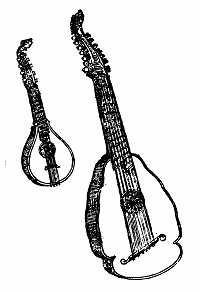 |
The Cittern and Bandora |
Lutes, guitars and vihuelas were all strung in gut. From the sixteenth century onwards, there was another whole family of plucked instruments strung in wire. Citterns were very popular throughout Europe. The English Cittern, having four courses, a bizarre but useful tuning, and often a built-in hook for wall hanging, had a low reputation, due to its popularity in taverns, barber shops and houses of ill repute. It is normally strummed with a crow quill, and it produces a rich, banjo-like sound which is ideal for accompanying vulgar ballads. Like the guitar, it has a limited published repertoire of simple fantasies. The French commonly used a five course instrument, and the Italians a six course, both of which attained honourable places at court. Citterns were made not only with different numbers of courses, but in different sizes, too. There were twelve course citterns, big bass citterns, and standard citterns carved with clowns' heads and painted in hideous, garish colours. Then, in the mid sixteenth century, a german bloke called Meuler invented a process for producing wire which would take much higher tension than standard brass. It allowed wire-strung instruments to be produced with a wide range, and all the subtlety of the lute. The bandora and orpharion were born - the first mainly used as a rich bass instrument in consorts, the second as a solo instrument. Forget harps in heaven - Anthony Holborne's fantasies played on an orpharion are as close to music of the angels as you're ever likely to hear. Enter the "broken consort". The name simply implies a consort made up of different types of instrument rather than different sizes of the same instrument. But there quickly arose a standard six-piece combo, usually known as the "English Consort", which was particularly effective, and which was the mainstay of theatre bands. This consisted of flute (or recorder), violin (or treble viol), bass viol, cittern, bandora, and a lute improvising gratuitously complex divisions. Some of the best composers wrote for this combination, and it was hugely popular. Until Meuler disappeared, taking his wire recipe with him. Did he die, was he got at by jealous competitors, sat on heavily by the guilds? I've heard various versions, and if anyone knows the authoritative version, please get in touch. Anyway, without Meuler's wire, the bandora and orpharion wouldn't work. No doubt they tried different tunings using standard wire, but it just wasn't the same, and both instuments quickly went out of use, after a brief but glorious career spanning about half a century. The broken consort had to change too, of course. Different combinations were tried, but none of them quite matched the richness and complexity of the English Consort with a bandora on the bass. All sorts of experiments were done with citterns during the 17th and 18th centuries, with varying success. They even tried the theorbo trick of multiple necks and long bass strings. The version that really caught on, though, was the "English Guitar", in the early 18th century. This was a citternish sort of thing, but with a much deeper body, six courses (including two single-strung overwound basses), an early version of machine heads requiring the use of a clock key, and a totally useless tuning of CEGceg. More capable players probably ignored the specified tuning stamped onto the machine head plate and used lute tuning or something similar, but idle young ladies, who should have been sweating away at developing a proper technique on their spinets and virginals, bought these pretty instruments and learned to pick out popular songs and opera melodies, usually ignoring anything as difficult as chords altogether. This fad was disastrous for spinet and harpsichord manufacturers, who suddenly faced potential bankruptcy due to the collapse of the fashionable young lady market. Kirkmann, one of the top London makers, decided to go down fighting. He made or acquired hundreds of English Guitars, all superficially pretty and sophisticated instruments, but on closer examination, produced at the very lowest price. I know. I recently restored one. We're talking about using reject mechanisms, artificial purfling inked in with a double-nib pen, the works. He sold these instruments dirt cheap, or in some cases probably gave them away, to every disreputable tavern and brothel in London. The ploy worked beautifully, reinforcing the reputation of the old English cittern, and killing the fashionable market stone dead. Lots of English Guitars ended up on bonfires or packed away in lofts, and within weeks, Kirkman was taking orders for harpsichords and spinets again. Beware of modern instruments called "citterns". They are perfectly respectable and useful instruments, and often used to good effect by folk musicians, but they have very little in common with the renaissance cittern, other than the name. That's not a problem, except that there are whole websites devoted to the cittern, created by enthusiastic folks who firmly believe that the modern cittern and the renaissance one are closely related, and pretty much different versions of the same instrument. Which they ain't. |
 Diabolus Homepage |
 Look up another Instrument |
 Email for Diabolus |
